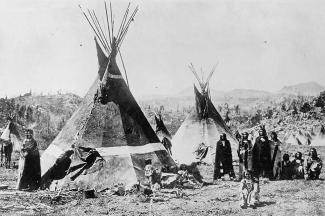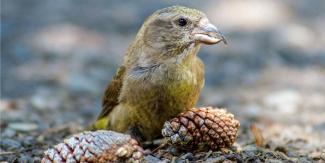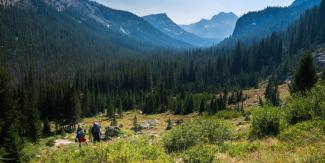Tallgrass to the forest
Sawtooth National Forest
Timothy Halleaux, Office of Communication
May 24th, 2024

In the heart of Idaho lies a prime example of natural beauty. The Sawtooth National Forest has majestic mountains and glistening lakes scattered over 2.1 million acres. It is also home to many flora and fauna on its lush, green forests. Hikers and photographers have enjoyed this spectacular landscape since its opening in 1905.

Shoshone tipi encampment in Idaho
Photo Credit: Photo courtesy of the Shoshone-Bannock Tribes Language and Cultural Preservation DepartmentHistory
This forest’s story with humans begins in time immemorial when Native American tribes - including the Shoshone-Bannock, Nez Perce and the Shoshone Paiute Tribes - migrated around the northern end of the forest, where they harvested timber, roots, and wild game. Today, many tribes live on nearby reservations the Sawtooth National Forest and still retain a deep connection with the land.
In the 1840s, European settler trails were established through the southern end of the forest. Two decades later, settler populations increased with miners and sheep ranchers using the natural resources found in the Sawtooth Mountains.
On May 29, 1905, President Theodore Roosevelt established the Sawtooth and Minidoka National Forest Reserves. The Sawtooth National Forest’s name came from the mountain range it encompasses. Two years later, the national forest reserve title was changed to “national forest.”
The forest’s protected land originally included only 1.9 million acres of land. Sawtooth National Forest expanded in 1953 with the integration of the Minidoka National Forest and again in 1972 with the addition of 756 thousand more acres of recreation area. The Sawtooth National Forest now encompasses 2.1 million acres of protected land for visitors to explore.

Toxaway Lake, Sawtooth National Recreation Area
Photo Credit: USDA Forest Service photo by Doug WewerGeography
Sawtooth National Forest includes many mountains, along with Hyndman Peak, the ninth-largest mountain in Idaho. Several glaciers and glacial lakes feed into the forest’s many rivers and to the Great Salt Lake.
A fault line runs forty miles through these mountains. The last significant earthquake on the Sawtooth National Forest is estimated to have occurred about four thousand years ago, though an earthquake today is always possible.
To protect visitors from hazardous conditions caused by these natural features, the Sawtooth Avalanche Center is on the national forest and monitors conditions.

The Cassia crossbill (Loxia sinesciuris) is only found in southern Idaho where they use their specially formed crisscrossed beaks to eat seeds from lodgepole pinecones. The Sawtooth National Forest provides critical habitat for these rare and unique birds.
Photo Credit: Photo courtesy of Craig Benkman, PhD
Wildlife
There are many animals that you may encounter during your wanderings on the Sawtooth National Forest. These animals include elk, wolves, bears, cougars, and trout.
Birdwatchers flock to the Sawtooth National Forest to see a unique bird species called the Cassia crossbill (Loxia sinesciuris). This red and brown finch with an unusual, crisscrossed beak only lives in a small area of southern Idaho near Cassia County on the Minidoka Ranger District. The Cassia Crossbill (PDF, 1.3 MB) was listed as a Bird of Conservation Concern in 2021 and relies on careful lodgepole pine habitat management provided by the Sawtooth National Forest.
If you do encounter one of these magnificent animals, please keep your distance – 25 feet from animals, and 100 feet from predators – and enjoy them from afar for your protection and theirs.
Recreation
The Sawtooth National Forest is popular with whitewater rafters, skiers, hunters, campers, and many other outdoor connoisseurs. There are two National Recreation Trails and over 1,000 miles of National Forest System trails for hikers and bikers to view the wildlife and scenery of the forest.
The forest also supports five ski resorts where visitors can downhill and cross-country ski. These slopes also host sporting events, such as the U.S. Alpine Ski Championships and other international skiing events and competitions.
Popular sites for visitors include the Rock Creek Complex, Ketchum Area Trails, Mount Harrison, South Fork of the Boise River, Redfish Lake, Stanley and Lower Stanley historic sites, East Fork of the Salmon River, Sawtooth Valley and Stanley Basin. Check out the Sawtooth National Forest Visitor Guide (PDF, 19.7 MB).

A couple of backpackers stop to take in the view on their way to Alpine Lake in Redfish Lake Canyon in the Sawtooth National Forest.
Photo Credit: USDA Forest ServiceLearn More
To learn more about Sawtooth National Forest and find current alerts and notifications, visit our website at fs.usda.gov/sawtooth.


